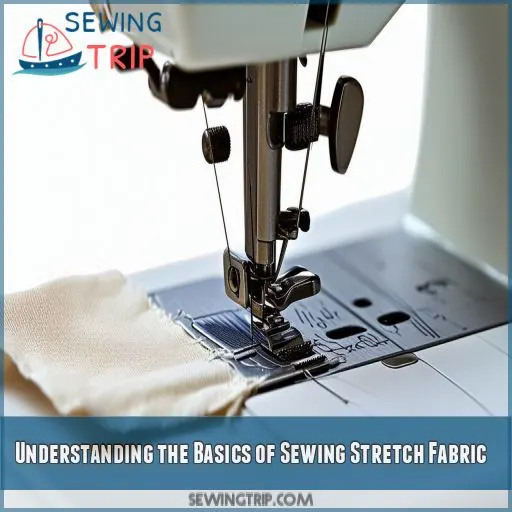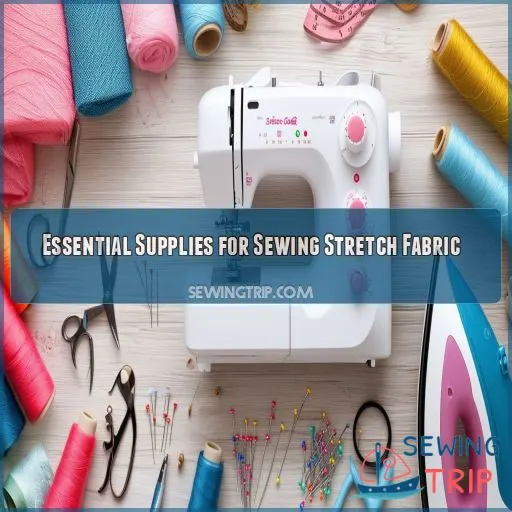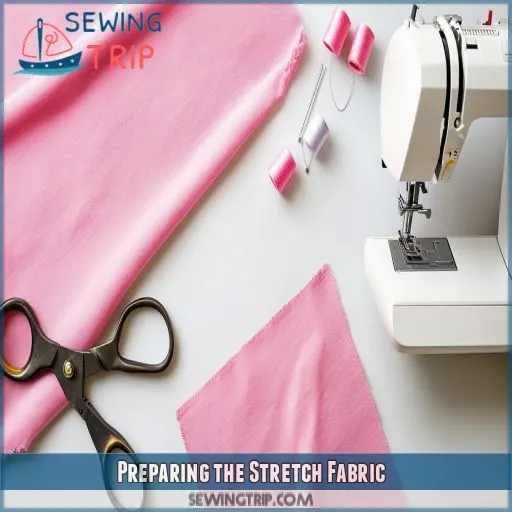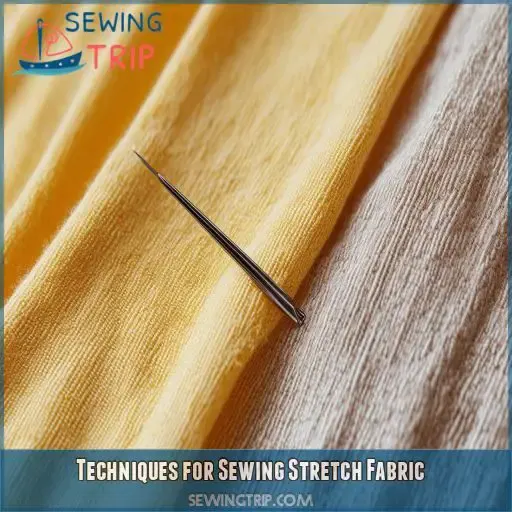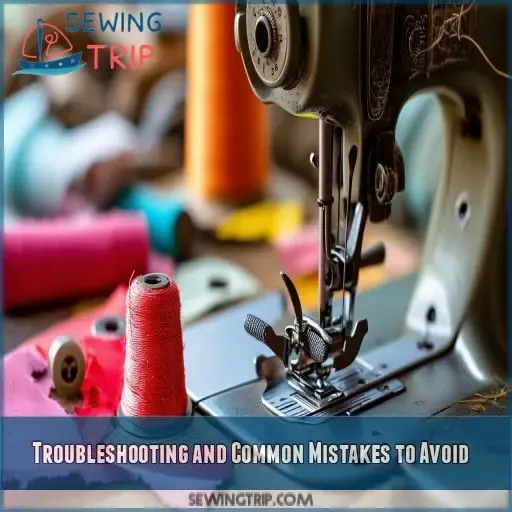This site is supported by our readers. We may earn a commission, at no cost to you, if you purchase through links.
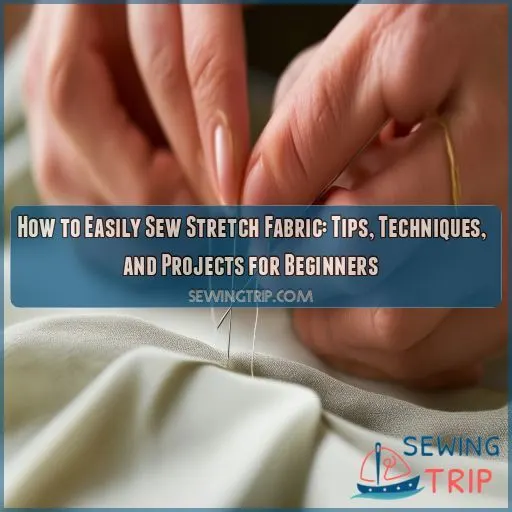
Here comes the actual way of learning all key tips and techniques on sewing stretch, explained precisely and organized without clutter for a beginner.
From necessary supplies to troubleshooting common mistakes—a complete guide so that your projects turn out pro.
Want to learn to sew stretchy fabrics easily and enlarge your sewing repertoire? Let’s get started!
Table Of Contents
- Key Takeaways
- How to Easily Sew Stretch Fabric?
- Understanding the Basics of Sewing Stretch Fabric
- Essential Supplies for Sewing Stretch Fabric
- Preparing the Stretch Fabric
- Techniques for Sewing Stretch Fabric
- Suggested Patterns and Projects for Stretch Fabric
- Troubleshooting and Common Mistakes to Avoid
- Frequently Asked Questions (FAQs)
- Conclusion
Key Takeaways
- Got an itch to sew with stretch fabric? Use the right needles and threads to avoid a wardrobe malfunction!
- It’s all about the prep! Pre-washing and cutting your fabric with care will save you from a stretchy nightmare.
- Don’t let your seams become a puckering mess! Use the correct stitches and presser feet to keep your fabric in line.
- Practice makes perfect! Don’t be afraid to experiment with different techniques and patterns until you’ve got the hang of it.
How to Easily Sew Stretch Fabric?
Sewing stretch fabric doesn’t have to be a headache. With the right tools and techniques, you can easily master it.
Start by grabbing a ballpoint or stretch needle, polyester thread, and a walking foot.
Use a narrow zigzag stitch for seams and a double needle for hems.
Stabilize with clear elastic or stay tape, and try topstitching, binding, or serging for a professional finish.
Pre-wash your fabric to prevent shrinkage, and cut with the direction of stretch.
Practice on scraps first to get the hang of it.
Once you get the basics down, you’ll be sewing stretchy fabrics like a pro in no time!
Understanding the Basics of Sewing Stretch Fabric
One can find sewing stretch fabrics rather intimidating, but once you know the facts, you’ll be turning out comfortable, fashionable garments in no time.
Stretch fabric varieties range from knits like jersey and spandex to woven fabrics that have a little give.
The key is to pay attention to the percent of stretch that the fabric has—the higher the stretch, the more specialized your sewing techniques must be.
Whatever fabric you’re using, be sure to use stretch-friendly needles and threads along with your stitches.
After a little practice on scrap fabric, you’ll join the realm of sewing with stretch and open up all sorts of sewing possibilities.
Essential Supplies for Sewing Stretch Fabric
You’ll need some basic supplies if you want to sew stretch fabric easily. For example, use a ballpoint or stretch needle with polyester thread to avoid skipped stitches. Use correct stitches and a walking foot to make sure the feeding is even and prevent the stretch from occurring while sewing.
Choosing the Right Needles and Threads
In sewing with stretch, the correct choice of a needle and thread is very important.
Ballpoint needles will help prevent fiber damage, while polyester thread allows excellent elasticity.
Use a thread-weight that corresponds to the thickness of your fabric so as not to have jerky stitches.
Make adjustments in tension settings in your sewing machine and stitch length depending upon the fabric requirement.
Beginning sewers will always turn out professional, strong seams using these methods.
Using the Correct Stitches and Presser Foot
For stretchy fabric sewing, use appropriate stitches and presser feet. Use the following:
- **Straight stitch for no stretch and other seam allowance essentials.
- **Zigzag stitch permits stretch and some flexibility.
- Twin needle for professional hems and finishes.
- **Even feed walking foot for no puckering.
These are the choices that will ensure efficient sewing and maintain the integrity of the fabric.
Preparing the Stretch Fabric
Before you start sewing, be sure to pre-wash your stretch fabric to prevent future shrinkage. When cutting, use sharp scissors or a rotary cutter on a single layer to avoid distorting the fabric’s stretch.
Pre-Washing and Cutting Techniques
Before you start sewing, pre-wash your stretch fabric to prevent future shrinkage. Cut stretch fabric using a rotary cutter for clean edges. Pay attention to the direction of stretch, especially with 4-way stretch fabric. Use a single layer for accuracy. Always remember the seam allowance and mark it with soap slivers for precision.
Marking and Handling Tips
When working with stretch fabrics, mark patterns using soap slivers or chalk – they won’t leave permanent marks. Baste or clip the fabric instead of pinning to avoid distorting the stretch. Measure carefully and use a ruler for precision. Adjust your presser foot pressure to prevent puckering. Choose stretch-friendly patterns and use a three-step zigzag stitch on single knit fabrics.
Techniques for Sewing Stretch Fabric
When sewing stretch fabric, use a narrow zigzag stitch for seams and a double needle for hems to maintain the fabric’s elasticity. Stabilize your fabric with clear elastic or stay tape to prevent stretching while sewing.
Stitching and Seam Finishing
For sewing with stretchy fabric and for finishing the seams, use a narrow zigzag or, if your machine has it, a lightning stitch. Use a ballpoint needle to prevent skipped stitches. This will look professional:
- Topstitching: To provide strength
- Binding: Creates clean edges
- Overlocking: Neatens raw edges
- Serging: Secures seam allowances
Hemming and Stabilizing Methods
To hem stretch fabric, consider using stay tape or fusing to stabilize the edges. For a clean hem, use a double needle on your sewing machine. Create a decorative, wavy lettuce hem by gently stretching the fabric while stitching. For knit fabric binding, utilize specific sewing machine features to achieve professional results without puckering.
Suggested Patterns and Projects for Stretch Fabric
As a beginner, you’ll find that stretch fabrics are perfect for creating comfortable and stylish garments. Try your hand at sewing a basic t-shirt or a pair of leggings – these projects are easy to tackle and showcase the benefits of working with stretch materials.
Beginner-Friendly Projects
Jump into sewing stretch fabric projects with these easy options:
- Basic T-shirt: Ideal for jersey or double knit. Follow a simple pattern.
- Leggings: Comfortable and perfect for lycra or scuba knit.
- Infinity Scarf: A quick project with minimal sewing.
- Skater Skirt: Beginner-friendly, especially with double knit fabric.
Choose patterns designed for beginners.
Tips for Sewing Lycra and Spandex
When sewing Lycra and Spandex, use small seam allowances for clean edges. Negative ease is very important; the fabric must have slight stretch.
Use a serger or a narrow zigzag for seams.
Curved seams are a special problem; bias tape or interfacing can be used to support these areas.
Always test on scraps so that you can finish refining your technique to get the best possible results.
Troubleshooting and Common Mistakes to Avoid
Sewing stretch fabrics can present some common challenges, but with the right techniques, you can avoid common mistakes and achieve professional-looking results. By understanding how to properly handle and stabilize stretch fabrics, you’ll be able to sew them with confidence and create high-quality garments.
Handling Common Sewing Challenges
Strategies can help one manage some common sewing challenges.
The tension of the presser foot could be designed not to distort or pucker the fabric.
Using a stretch needle and thread would keep broken needles and skipped stitches at bay.
Walking feet will provide even seams, while scraps should be practiced first before doing the real deal.
Perfect techniques by doing beginners like making a ruffle shrug or pool chair cover.
Avoiding Mistakes for Professional Results
Master the techniques for pinning and interfacing options for non-stretch stabilizing to avoid these common traps. Hem stretch fabrics with care. Not in a rush? Well, practice makes perfect. Take the time to play around with the stitch length and tension on scraps. Patience will get you a garment that looks polished, fits great, and will last.
Frequently Asked Questions (FAQs)
Is there a trick to sewing stretchy fabric?
Sewing stretchy fabrics is a breeze when you’ve got the right tools and techniques. Use a stretch needle, adjust your stitch length, and take it slow – you’ll be sewing like a pro in no time!
Can you sew stretchy fabric with a regular sewing machine?
Yes, you can sew stretchy fabric with a regular sewing machine. Simply use a stretch needle and stretch thread, and select a stretch stitch to maintain elasticity. Practicing on scraps helps refine your technique.
What is the best stitch for sewing stretch fabric?
The best stitch for sewing stretch fabric is a narrow zigzag stitch. It allows the fabric to stretch without breaking the thread, providing durability and flexibility for your stretchy garments.
Why can’t I sew stretchy fabric?
If you’re struggling to sew stretchy fabric, it’s likely because you’re not using the right needle, thread, or stitch. Try a stretch needle, polyester thread, and a zigzag or stretch stitch – that should do the trick!
Can you dye stretch fabrics effectively?
Yes, it’s possible to dye stretch fabrics. You’ll need fiber-reactive dyes for natural fibers and acid dyes for synthetic blends. Make sure the fabric is clean, and get the best results by following the instructions on the dye manufacturer’s package.
How to care for garments made from stretch fabric?
To care for garments made from stretch fabric, wash them in cold water, use a gentle cycle, and avoid bleach. Lay flat to dry or tumble dry on low, never ironing directly to preserve elasticity.
What are the best storage practices for stretch fabrics?
Store stretch fabrics flat or folded loosely to prevent creasing. Avoid hanging, as the weight can distort the fabric. Keep them in a cool, dry place away from direct sunlight to maintain their stretch and shape.
Can you prevent stretch fabric from shrinking?
Sure, just use fabric that mysteriously defies the laws of nature. Seriously though, pre-wash your fabric in cold water and air dry it. This prevents shrinkage before you start sewing, saving your masterpiece from disaster.
How to repair holes in stretch fabric?
To repair holes in stretch fabric, start by placing a patch of matching fabric underneath the hole. Use a zigzag stitch around the edges to secure it, ensuring the fabric stretches as you sew.
Conclusion
Think of sewing as a dance between fabric and needle, where mastering the steps leads to beautiful creations. Armed with these tips on how to easily sew stretch fabric, you’re ready to tackle any project.
With the right supplies, preparation, and techniques, you’ll create professional-grade garments like leggings and T-shirts with ease. Remember, practice makes perfect, and soon, handling stretchy fabrics will become second nature.
Let your imagination and skills stretch widely, creating wonders.

